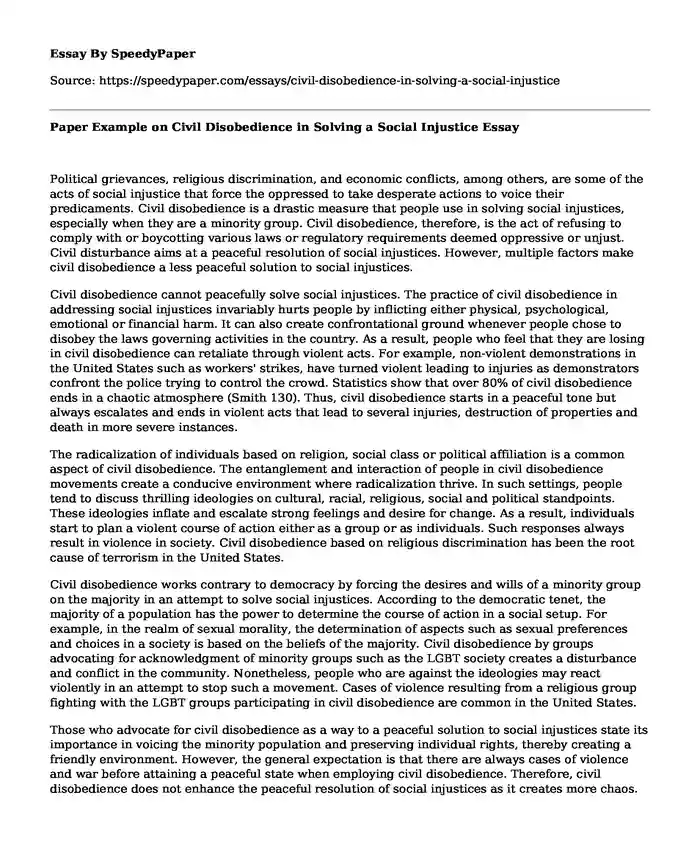
| Type of paper: | Essay |
| Categories: | Social justice Civil rights Social issue |
| Pages: | 3 |
| Wordcount: | 647 words |
Political grievances, religious discrimination, and economic conflicts, among others, are some of the acts of social injustice that force the oppressed to take desperate actions to voice their predicaments. Civil disobedience is a drastic measure that people use in solving social injustices, especially when they are a minority group. Civil disobedience, therefore, is the act of refusing to comply with or boycotting various laws or regulatory requirements deemed oppressive or unjust. Civil disturbance aims at a peaceful resolution of social injustices. However, multiple factors make civil disobedience a less peaceful solution to social injustices.
Civil disobedience cannot peacefully solve social injustices. The practice of civil disobedience in addressing social injustices invariably hurts people by inflicting either physical, psychological, emotional or financial harm. It can also create confrontational ground whenever people chose to disobey the laws governing activities in the country. As a result, people who feel that they are losing in civil disobedience can retaliate through violent acts. For example, non-violent demonstrations in the United States such as workers' strikes, have turned violent leading to injuries as demonstrators confront the police trying to control the crowd. Statistics show that over 80% of civil disobedience ends in a chaotic atmosphere (Smith 130). Thus, civil disobedience starts in a peaceful tone but always escalates and ends in violent acts that lead to several injuries, destruction of properties and death in more severe instances.
The radicalization of individuals based on religion, social class or political affiliation is a common aspect of civil disobedience. The entanglement and interaction of people in civil disobedience movements create a conducive environment where radicalization thrive. In such settings, people tend to discuss thrilling ideologies on cultural, racial, religious, social and political standpoints. These ideologies inflate and escalate strong feelings and desire for change. As a result, individuals start to plan a violent course of action either as a group or as individuals. Such responses always result in violence in society. Civil disobedience based on religious discrimination has been the root cause of terrorism in the United States.
Civil disobedience works contrary to democracy by forcing the desires and wills of a minority group on the majority in an attempt to solve social injustices. According to the democratic tenet, the majority of a population has the power to determine the course of action in a social setup. For example, in the realm of sexual morality, the determination of aspects such as sexual preferences and choices in a society is based on the beliefs of the majority. Civil disobedience by groups advocating for acknowledgment of minority groups such as the LGBT society creates a disturbance and conflict in the community. Nonetheless, people who are against the ideologies may react violently in an attempt to stop such a movement. Cases of violence resulting from a religious group fighting with the LGBT groups participating in civil disobedience are common in the United States.
Those who advocate for civil disobedience as a way to a peaceful solution to social injustices state its importance in voicing the minority population and preserving individual rights, thereby creating a friendly environment. However, the general expectation is that there are always cases of violence and war before attaining a peaceful state when employing civil disobedience. Therefore, civil disobedience does not enhance the peaceful resolution of social injustices as it creates more chaos.
In conclusion, civil disobedience is an effective way to solve social injustices, especially when the justice system fails in society. However, civil disobedience does not guarantee a peaceful resolution of social injustices. It is a confrontation means of solving the inequalities that result in conflicts with governmental institutions as well as individuals. It also creates a loophole where individuals can take that opportunity to violate other unrelated regulations. It goes against the primary goal of democracy leading to conflicts between the minority and the majority.
Work Cited
Smith, William. Civil disobedience and deliberative democracy. Routledge, 2013.
Cite this page
Paper Example on Civil Disobedience in Solving a Social Injustice. (2023, Apr 10). Retrieved from https://speedypaper.net/essays/civil-disobedience-in-solving-a-social-injustice
Request Removal
If you are the original author of this essay and no longer wish to have it published on the SpeedyPaper website, please click below to request its removal:
- Free Essay Sample: America and Freedom
- Robin Hood and Management, Business Essay Sample
- Stress Management in Single Mothers - Group Proposal Experience
- Report Paper Sample: Exxon Mobil Company
- Paper Sample. Women's Leadership in Kuwait
- Free Essay. Reengineering of Health Care
- Exploring Challenges and Solutions in Criminal Justice - Free Essay Sample
Popular categories




